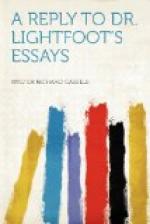“The case of Lipsius is especially instructive, as illustrating this point. Having at one time maintained the priority and genuineness of the Curetonian letters, he has lately, if I rightly understand him, retracted his former opinion on both questions alike.” [60:2]
Dr. Lightfoot, however, has not, rightly understood him. Lipsius has only withdrawn his opinion that the Syriac letters are authentic, but, whilst now asserting that in all their forms the Ignatian Epistles are spurious, he still maintains the priority of the Curetonian version. He first announced this change of view emphatically in 1873, when he added: “An dem relativ groessern Alter der syrischen Textgestalt gegenueber der kuerzeren griechischen halte ich uebrigens nach wie vor fest.” [61:1] In the very paper to which Dr. Lightfoot refers, Lipsius also again says quite distinctly: “Ich bin noch jetzt ueberzeugt, dass der Syrer in zahlreichen Faellen den relativ urspruenglichsten Text bewahrt hat (vgl. meine Nachweise in ‘Niedner’s Zeitschr.’ S. 15ff).” [61:2] With regard to the whole of this (2) point, it must be remembered that the only matter in question is simply a shade of opinion amongst critics who deny the authenticity of the Ignatian Epistles in all forms.
Dr. Lightfoot, however, goes on “to throw some light upon this point” by analysing my “general statement of the course of opinion on this subject given in an earlier passage.” [61:3] The “light” which he throws seems to pass through so peculiar a medium, that I should be much rather tempted to call it darkness. I beg the reader to favour me with his attention to this matter, for here commences a serious attack upon the accuracy of my notes and statements, which is singularly full of error and misrepresentation. The general statement referred to and quoted is as follows:—
“These three Syriac epistles have been subjected to the severest scrutiny, and many of the ablest critics have pronounced them to be the only authentic Epistles of Ignatius, whilst others, who do not admit that even these are genuine letters emanating from Ignatius, prefer them to the version of seven Greek epistles, and consider them the most ancient form of the letters which we possess.(1) As early as the sixteenth century, however, the strongest doubts were expressed regarding the authenticity of any of the epistles ascribed to Ignatius. The Magdeburg Centuriators first attacked them, and Calvin declared (p. 260) them to be spurious,[^1] an opinion fully shared by Chemnitz, Dallaeus, and others; and similar doubts, more or less definite, were expressed throughout the seventeenth century,(2) and onward to comparatively recent times,(3) although the means of forming a judgment were not then so complete as now. That the epistles were interpolated there was no doubt. Fuller examination and more comprehensive knowledge of the subject have confirmed earlier doubts, and a large mass of critics recognise that the




